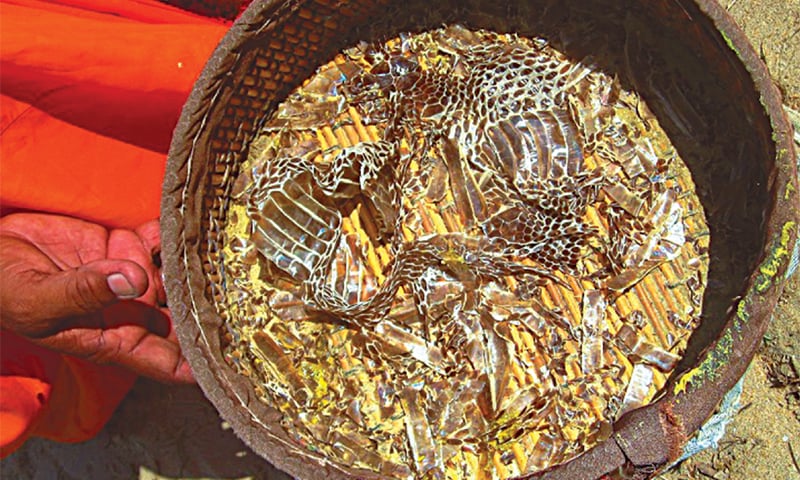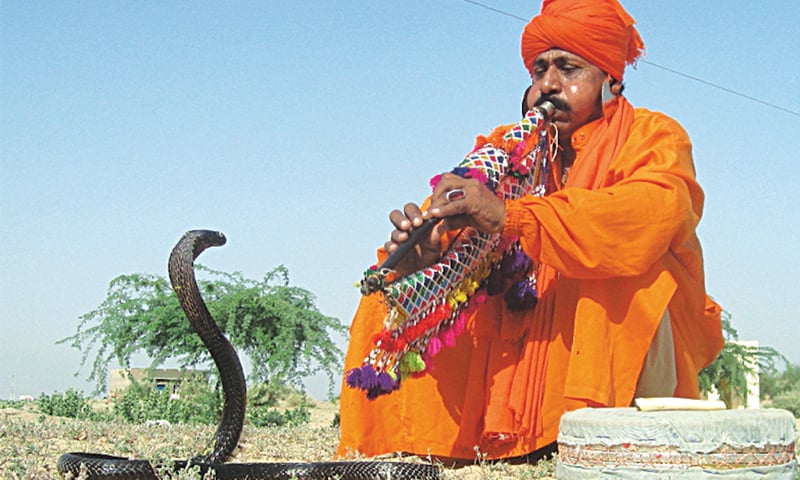It was around midday when we entered the colony, just in time to catch Ustad Misri Jogi’s class in the courtyard outside his small temple. The ustad is conspicuous by his orange turban, a long orange robe and very large earrings. There are no desks or blackboards for the group of children assembled in the courtyard; everyone sits on the ground and waits for their teacher to start the class.
Ustad Misri draws two round straw baskets. Sleeping inside these are two black cobras, who are duly woken up. Ustad keeps his murli or been (snake charmers’ flute) by his side. Then he picks up a dry, pipe-shaped goat bone and a brass lota filled with water. He opens one basket, extracts one of the cobras and then holds his head open with one hand. The dry bone is then inserted, and ustad begins funnelling water from the lota into the serpent’s mouth.
“In the wild, snakes get food on their own; but when we keep them in custody, we have to feed them milk and water this way,” Ustad Misri explains to the group of students.
Inside the colony of Jogi Daro in Umerkot, snakes and humans live together under a contract: no serpent will ever harm any individual of the colony
Known as ustad (teacher) amongst his disciples, Ustad Misri is also chieftain of his tribe living in the colony. This kind of lesson is not organised on a daily basis; it is only sometimes that ustad asks the children for their time so that he can teach them some snake charming techniques that every jogi must know. There are moments of wondrous amazement too: ustad shows the gathered children a serpent’s molten skin, shed due to the summer heat.
 |
| The teenage Jogis of Jogi Daro Colony of Umerkot also learn Nangan Dance to earn their living by performing at Melas and other gatherings |
This isn’t a routine class, but then this isn’t any routine colony either. This is the mound of snake charmers, Jogi Daro, which was once situated about one-and-a-half kilometres away from Umerkot city. With Umerkot’s population swelling and new housing schemes having popped up to meet demand, Jogi Daro now finds itself part of the city proper.
Each house owns at least one black Indian cobra, but most actually own several snakes, including cobras, kraits and vipers, locally known as Lundi Bala. None of the serpents are defanged but children play with them as if they were toys. Ustad says this is because a certain contract exists between the jogis and the serpents living with them.
“A snake cannot bite a jogi child, and even if it does, it will not harm our child since we administer a drop of snake venom as suti (first food) to our newborns. This establishes immunity against snake poison for their entire life,” claims Ustad Misri.
Jogis or snake charmers are a gypsy community in Sindh. They mostly wander around the entire year from one place to another, either in search of a livelihood or a snake. Temporary jogi settlements can be found across Sindh, including in Thar Nabisar and Chelh Bund of Umerkot district, Rohri in Sukkur, Jhimpir and Makli in Thatta district, and Gadap Town of Karachi.
 |
| Jogi Daro colony is established on a plot allotted by the former prime minister Zulfikar Ali Bhutto |
But in Jogi Daro, these gypsies have permanent, settled homes. “In the late 1970s, during Zulfikar Ali Bhutto’s government, a girl from our community was kidnapped. We approached our MNA at the time, Rana Chander Singh, for help. He managed to recover the girl and requested Bhutto to give this land to us. Ever since, we have been living here,” says Ustad Misri.
There are around 100 families living in the colony. Most houses in the colony are not built in any sequence but are scattered. Some houses are, in fact, makeshift huts while others are cemented houses without a boundary wall. There are no paved streets either.
Each child in the colony has between six and eight siblings; almost every child has seen their hair change colour from black to golden, which confirms severe protein deficiency. Women wear old-style gold and heavy silver jewellery, and almost every woman has traditional tattoos on their forehead, neck or their hands. Minor girls in the community get these tattoos at an early age.
Historically, Sindhi jogis included both Hindus and Muslims, but over time, most Muslim jogis left their ancestral profession of snake charming, got education and secured government and private jobs. A few Muslim jogis still exist, but they are few and far between.
 |
| The molten cobra skin |
This trend seems to be catching on among Hindu jogis too. Due to environmental degradation, increasing population, deforestation and undesirable human interventions in the wild, these jogis are no longer finding snakes in the wild with as much ease as they used to before. With the passage of time, people’s interest in snakes and snake charmers has also decreased — as a result, the new generation of jogis is also leaving their forefathers’ profession.
As is the custom in Jogi Daro, those who temporarily left the colony this year too to visit other cities in search of a livelihood had covered their huts’ entrance with thorny branches. Those present in the colony describe that in other cities, a male jogi earns money by making their serpents dance to the tune of the rhythm of the been (snake charmers’ flute).
Women jogis are usually palmists, who go door to door to serve those interested in fortune telling. Sometimes, they also earn money by cleaning ear wax — they carry a traditional, small pipe to suck and retrieve wax. This job too has a market in the city.
It is for people such as these, still vested in their ancestral profession, that ustad still offers a class in snake charming. Not only does the ancient craft survive this way, but according to ustad, these are “essential survival skills for when they grow up”.
 |
| Barefooted children of Jogi Daro Colony play with snakes and other reptiles instead of toys |
To prove themselves as “real jogis”, many in the colony also keep various artefacts that are believed to have magical characteristics. “There are mainly three things that have a magical impact: mann or manka, gidar singhi and hatha joti,” explains Ustad Misri. “Because of their properties, we consider them very useful, often keep it on us, and also try to give these to our daughters as dowry when they get married.”
Mann or manka is a black stone-like bead, which the jogis claim is actually taken from inside a snake head. A gidar singhi is the horn of a special jackal that is as small as a squirrel and lives in mountainous or hilly areas. Many Sindhi jogis go to Kherthar, Kanbhoo Jabal, Bhit Jabal, the mountains in Dadu and Jamshoro district of Sindh or Koh-i-Suleman of Balochistan in search of this precious gidar singhi. Hatha jodi is the root of a certain plant that looks like human hands with folded arms.
The gypsy tribe of jogis doesn’t take their sick to the hospital too often; most rely on traditional remedies and cures. A black thread tied with holy verses and wrapped in a leather amulet is considered the best treatment for many diseases.
“It has been more than four decades since the government allotted resident plots to the snake charmers of Jogi Daro, but even today, there are no basic facilities in the colony,” complains Dharmoon Jogi, another elderly resident of the colony. “There is no proper sanitation system, no water supply, no street lights and no paved streets either. We demand of the government to provide us these basic facilities.”
Despite the obvious hardships, Ustad Misri is adamant that he won’t let the craft of snake charming wither away as long as there are children willing to learn. “You must be born a jogi to learn these centuries-old snake charming skills. No one can learn to be jogi,” asserts ustad.
Amar Guriro is a senior journalist based in Karachi. He tweets @AmarGuriro
Published in Dawn, Sunday Magazine, July 26th, 2015
On a mobile phone? Get the Dawn Mobile App: Apple Store | Google Play
















































Dear visitor, the comments section is undergoing an overhaul and will return soon.